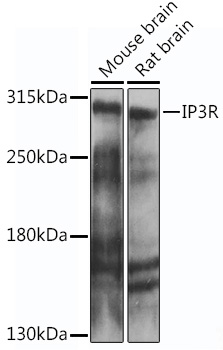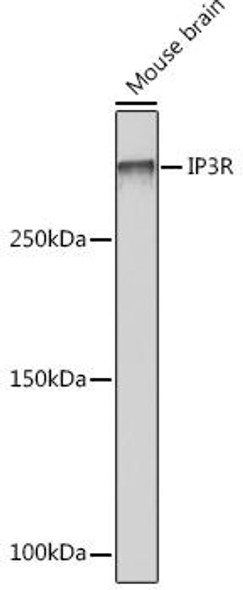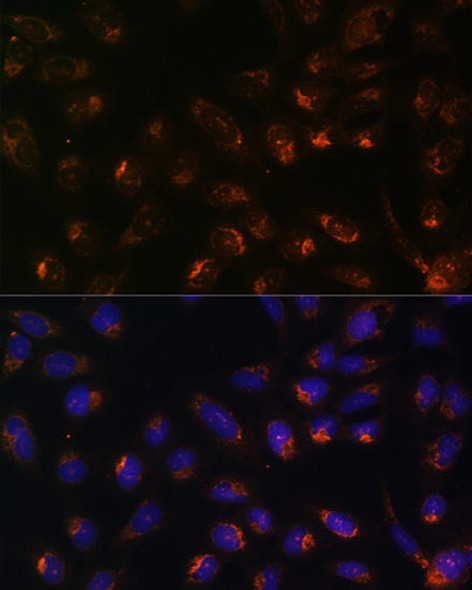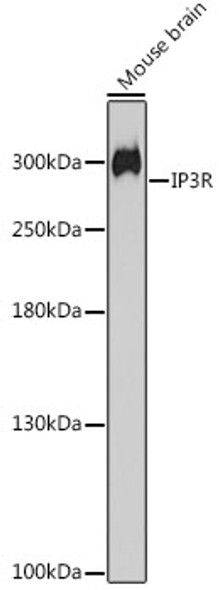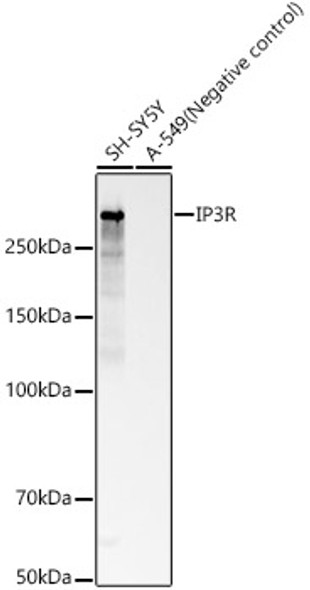Cell Death Antibodies 1
Anti-IP3R Antibody (CAB14008)
- SKU:
- CAB14008
- Product Type:
- Antibody
- Reactivity:
- Human
- Reactivity:
- Mouse
- Reactivity:
- Rat
- Host Species:
- Rabbit
- Isotype:
- IgG
- Antibody Type:
- Polyclonal Antibody
- Research Area:
- Cell Death
Description
| Antibody Name: | Anti-IP3R Antibody |
| Antibody SKU: | CAB14008 |
| Antibody Size: | 20uL, 50uL, 100uL |
| Application: | WB IF |
| Reactivity: | Human, Mouse, Rat |
| Host Species: | Rabbit |
| Immunogen: | Recombinant fusion protein containing a sequence corresponding to amino acids 1100-1250 of human IP3R (NP_001161744.1). |
| Application: | WB IF |
| Recommended Dilution: | WB 1:500 - 1:2000 IF 1:50 - 1:200 |
| Reactivity: | Human, Mouse, Rat |
| Positive Samples: | Mouse brain, Rat brain |
| Immunogen: | Recombinant fusion protein containing a sequence corresponding to amino acids 1100-1250 of human IP3R (NP_001161744.1). |
| Purification Method: | Affinity purification |
| Storage Buffer: | Store at -20'C. Avoid freeze / thaw cycles. Buffer: PBS with 0.02% sodium azide, 50% glycerol, pH7.3. |
| Isotype: | IgG |
| Sequence: | TSQD VDNY KQIK QDLD QLRS IVEK SELW VYKG QGPD ETMD GASG ENEH KKTE EGNN KPQK HEST SSYN YRVV KEIL IRLS KLCV QESA SVRK SRKQ QQRL LRNM GAHA VVLE LLQI PYEK AEDT KMQE IMRL AHEF LQNF CAGN QQNQ ALL |
| Gene ID: | 3708 |
| Uniprot: | Q14643 |
| Cellular Location: | Endoplasmic reticulum membrane, Multi-pass membrane protein |
| Calculated MW: | 306-313kDa |
| Observed MW: | 315kDa |
| Synonyms: | ITPR1, ACV, CLA4, INSP3R1, IP3R, IP3R1, PPP1R94, SCA15, SCA16, SCA29 |
| Background: | This gene encodes an intracellular receptor for inositol 1, 4, 5-trisphosphate. Upon stimulation by inositol 1, 4, 5-trisphosphate, this receptor mediates calcium release from the endoplasmic reticulum. Mutations in this gene cause spinocerebellar ataxia type 15, a disease associated with an heterogeneous group of cerebellar disorders. Multiple transcript variants have been identified for this gene. |
| UniProt Protein Function: | IP3R1: a multi-pass endoplasmic reticulum membrane receptor for inositol 1,4,5-trisphosphate, a second messenger that mediates the release of intracellular calcium. Plays a role in ER stress-induced apoptosis. Cytoplasmic calcium released from the ER triggers apoptosis by the activation of CaMKII, eventually leading to the activation of downstream apoptosis pathways. Part of a cGMP kinase signaling complex that includes alpha-actin, calponin H1, phospholamban, PKG1 and IP3R1. Widely expressed. The receptor contains a calcium channel in its C-terminal extremity. Its large N-terminal cytoplasmic region has the ligand-binding site in the N-terminus and modulatory sites in the middle portion immediately upstream of the channel region. Phosphorylation by PKA prevents the ligand-induced opening of the calcium channels. Belongs to the ryanodine-inositol 1,4,5-triphosphate receptor ca(2+) channel (rir-cac) family. Eight alternatively spliced isoforms have been described. |
| UniProt Protein Details: | Protein type:Channel, ligand-gated; Channel, calcium; Membrane protein, multi-pass; Membrane protein, integral Chromosomal Location of Human Ortholog: 3p26.1 Cellular Component: calcineurin complex; endoplasmic reticulum; endoplasmic reticulum membrane; integral to membrane; membrane; nuclear inner membrane; nucleolus; platelet dense granule membrane; postsynaptic density; sarcoplasmic reticulum Molecular Function:calcium channel inhibitor activity; calcium ion transmembrane transporter activity; inositol 1,4,5-triphosphate-sensitive calcium-release channel activity; intracellular ligand-gated calcium channel activity; phosphoinositide binding; protein binding Biological Process: blood coagulation; calcium ion transport; endoplasmic reticulum calcium ion homeostasis; energy reserve metabolic process; epidermal growth factor receptor signaling pathway; epithelial fluid transport; fibroblast growth factor receptor signaling pathway; innate immune response; inositol phosphate-mediated signaling; negative regulation of calcium-mediated signaling; nerve growth factor receptor signaling pathway; phospholipase C activation; platelet activation; post-embryonic development; regulation of insulin secretion; release of sequestered calcium ion into cytosol; response to hypoxia; signal transduction; stimulatory C-type lectin receptor signaling pathway; vascular endothelial growth factor receptor signaling pathway; voluntary musculoskeletal movement |
| NCBI Summary: | This gene encodes an intracellular receptor for inositol 1,4,5-trisphosphate. Upon stimulation by inositol 1,4,5-trisphosphate, this receptor mediates calcium release from the endoplasmic reticulum. Mutations in this gene cause spinocerebellar ataxia type 15, a disease associated with an heterogeneous group of cerebellar disorders. Multiple transcript variants have been identified for this gene. [provided by RefSeq, Nov 2009] |
| UniProt Code: | Q14643 |
| NCBI GenInfo Identifier: | 519668682 |
| NCBI Gene ID: | 3708 |
| NCBI Accession: | Q14643.3 |
| UniProt Secondary Accession: | Q14643,Q14660, Q99897, E7EPX7, E9PDE9, |
| UniProt Related Accession: | Q14643 |
| Molecular Weight: | |
| NCBI Full Name: | Inositol 1,4,5-trisphosphate receptor type 1 |
| NCBI Synonym Full Names: | inositol 1,4,5-trisphosphate receptor type 1 |
| NCBI Official Symbol: | ITPR1 |
| NCBI Official Synonym Symbols: | ACV; CLA4; IP3R; IP3R1; SCA15; SCA16; SCA29; INSP3R1; PPP1R94 |
| NCBI Protein Information: | inositol 1,4,5-trisphosphate receptor type 1 |
| UniProt Protein Name: | Inositol 1,4,5-trisphosphate receptor type 1 |
| UniProt Synonym Protein Names: | IP3 receptor isoform 1; IP3R 1; InsP3R1; Type 1 inositol 1,4,5-trisphosphate receptor; Type 1 InsP3 receptor |
| Protein Family: | Inositol 1,4,5-trisphosphate receptor |
| UniProt Gene Name: | ITPR1 |
| UniProt Entry Name: | ITPR1_HUMAN |


